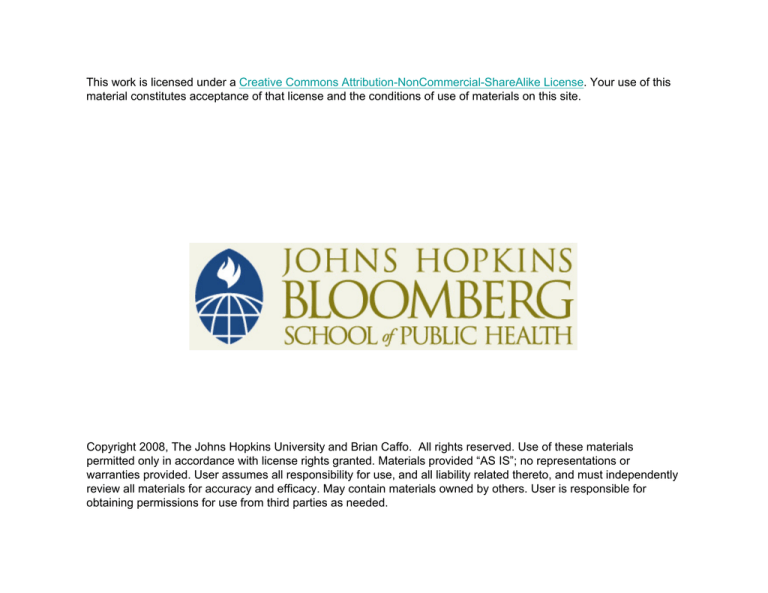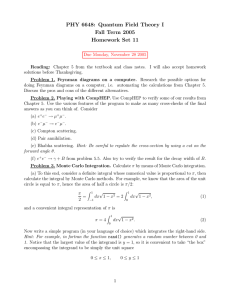
This work is licensed under a Creative Commons Attribution-NonCommercial-ShareAlike License. Your use of this
material constitutes acceptance of that license and the conditions of use of materials on this site.
Copyright 2008, The Johns Hopkins University and Brian Caffo. All rights reserved. Use of these materials
permitted only in accordance with license rights granted. Materials provided “AS IS”; no representations or
warranties provided. User assumes all responsibility for use, and all liability related thereto, and must independently
review all materials for accuracy and efficacy. May contain materials owned by others. User is responsible for
obtaining permissions for use from third parties as needed.
Lecture 16
Brian Caffo
Table of
contents
Outline
Power
Calculating
power
Lecture 16
T-tests
Monte Carlo
Brian Caffo
Department of Biostatistics
Johns Hopkins Bloomberg School of Public Health
Johns Hopkins University
December 19, 2007
Lecture 16
Table of contents
Brian Caffo
Table of
contents
Outline
Power
Calculating
power
T-tests
1 Table of contents
2 Outline
Monte Carlo
3 Power
4 Calculating power
5 T-tests
6 Monte Carlo
Lecture 16
Outline
Brian Caffo
Table of
contents
Outline
Power
Calculating
power
T-tests
Monte Carlo
1
Power
2
Power for a one sided normal test
3
Power for t-test
Lecture 16
Power
Brian Caffo
Table of
contents
Outline
Power
Calculating
power
T-tests
Monte Carlo
• Power is the probability of rejecting the null hypothesis
when it is false
• Ergo, power (as it’s name would suggest) is a good thing;
you want more power
• A type II error (a bad thing, as its name would suggest) is
failing to reject the null hypothesis when it’s false; the
probability of a type II error is usally called β
• Note Power = 1 − β
Lecture 16
Notes
Brian Caffo
Table of
contents
Outline
Power
Calculating
power
T-tests
Monte Carlo
• Consider our previous example involving RDI
• H0 : µ = 30 versus Ha : µ > 30
• Then power is
P
X̄ − 30
√ > t1−α,n−1 | µ = µa
s/ n
• Note that this is a function that depends on the specific
value of µa !
• Notice as µa approaches 30 the power approaches α
Lecture 16
Brian Caffo
Table of
contents
Outline
Power
Calculating
power
T-tests
Monte Carlo
Calculating power
Assume that n is large and that we know σ
X̄ − 30
√ > z1−α | µ = µa
1−β = P
σ/ n
X̄ − µa + µa − 30
√
= P
> z1−α | µ = µa
σ/ n
µa − 30
X̄ − µa
√ > z1−α −
√ | µ = µa
= P
σ/ n
σ/ n
µa − 30
√ | µ = µa
= P Z > z1−α −
σ/ n
Lecture 16
Brian Caffo
Example continued
Table of
contents
Outline
Power
Calculating
power
T-tests
Monte Carlo
• Suppose that we wanted to detect a increase in mean RDI
of at least 2 events / hour. Assume normality and that the
sample in question will have a standard deviation of 4;
what would be the power if we took a sample size of 16?
√
a −30
√ = 2/(4/ 16) = 2
• Zα = 1.645 and µσ/
n
• P(Z > 1.645 − 2) = P(Z > −0.355) = 64%
Lecture 16
Example continued
Brian Caffo
Table of
contents
Outline
Power
Calculating
power
T-tests
Monte Carlo
• What n would be required to get a power of 80%
• I.e. we want
µa − 30
√ | µ = µa
0.80 = P Z > z1−α −
σ/ n
a −30
√ = z0.20 and solve for n
• Set z1−α − µσ/
n
Lecture 16
Notes
Brian Caffo
Table of
contents
Outline
Power
Calculating
power
T-tests
Monte Carlo
• The calculation for Ha : µ > µ0 is similar
• For Ha : µ 6= µ0 calculate the one sided power using α/2
(this is only approximately right, it excludes the probability
of getting a large TS in the opposite direction of the truth)
• Power goes up as α gets larger
• Power of a one sided test is greater than the power of the
associated two sided test
• Power goes up as µ1 gets further away from µ0
• Power goes up as n goes up
Lecture 16
Power for the T test
Brian Caffo
Table of
contents
Outline
Power
Calculating
power
• Consider calculating power for a Gossett’s T test for our
example
• The power is
T-tests
Monte Carlo
P
X̄ − 30
√ > t1−α,n−1 | µ = µa
S/ n
• Notice that this is equal to
= P
√
n(X̄ − 30)+ > t1−α,n−1 S | µ = µa
√
= P
S
n(X̄ − 30)
+ > t1−α,n−1 | µ = µa
σ
σ
Lecture 16
Continued
Brian Caffo
Table of
contents
• Continued
Outline
√
Power
Calculating
power
P
n(X̄ − µa )
+
σ
!
r
√
t1−α,n−1
n(µa − 30)
(n − 1)S 2
> √
×
σ
σ2
n−1
T-tests
Monte Carlo
(where we ommitted the conditional on µa part for space)
• This is now equal to
√
t1−α,n−1 q 2
n(µa − 30)
> √
χn−1
P Z+
σ
n−1
where Z and χ2n−1 are independent standard normal and
chi-squared random variables
• While computing this probability is outside the scope of
the class, it would be easy to approximate with Monte
Carlo
Lecture 16
Brian Caffo
Example
Table of
contents
Outline
Power
Calculating
power
T-tests
Monte Carlo
Let’s recalculate power for the previous example using the T
distribution instead of the normal; here’s the easy way to do it.
Let σ = 4 and µa − µ0 = 2
##the easy way
power.t.test(n = 16, delta = 2 / 4,
type = "one.sample",
alt = "one.sided")
##result is 60%
Lecture 16
Example
Brian Caffo
Table of
contents
Outline
Using Monte Carlo
Power
Calculating
power
T-tests
Monte Carlo
nosim <- 100000
n <- 16
sigma <- 4
mu0 <- 30
mua <- 32
z <- rnorm(nosim)
xsq <- rchisq(nosim, df = 15)
t <- qt(.95, 15)
mean(z + sqrt(n) * (mua - mu0) / sigma >
t / sqrt(n - 1) * sqrt(xsq))
##result is 60%
Lecture 16
Comments
Brian Caffo
Table of
contents
Outline
Power
Calculating
power
T-tests
Monte Carlo
• Notice that in both cases, power required a true mean and
a true standard deviation
• However in this (and most linear models) the power
depends only on the mean (or change in means) divided
by the standard deviation







